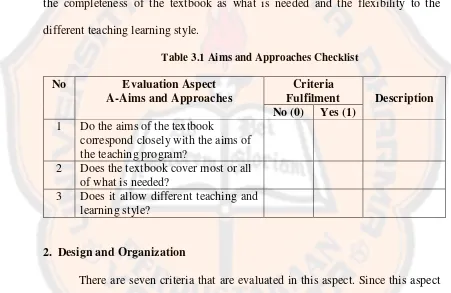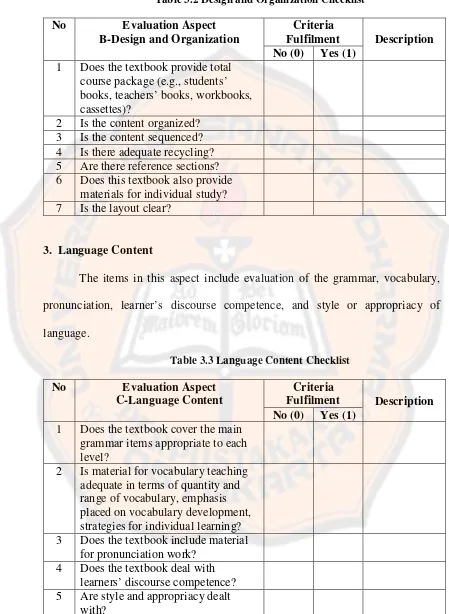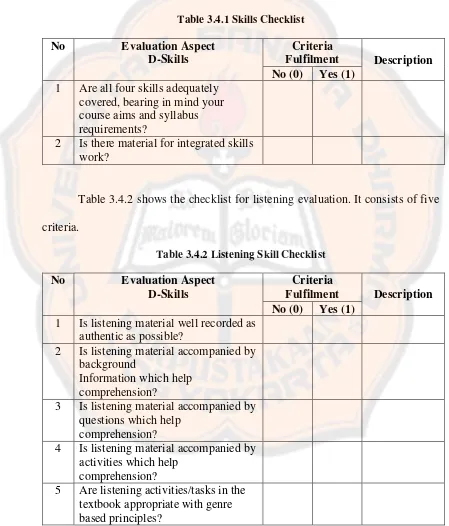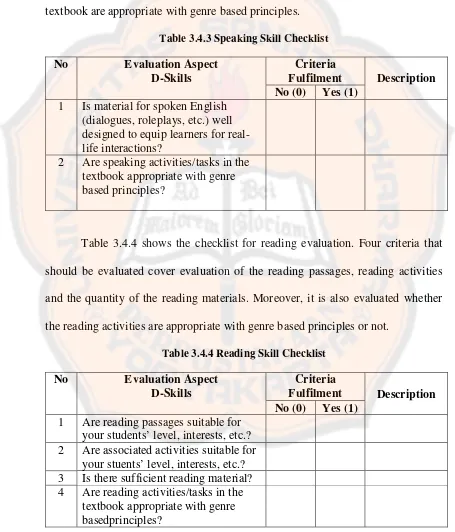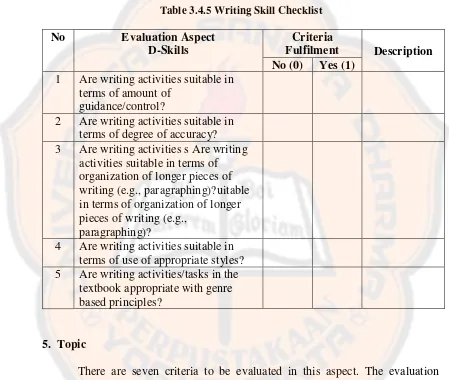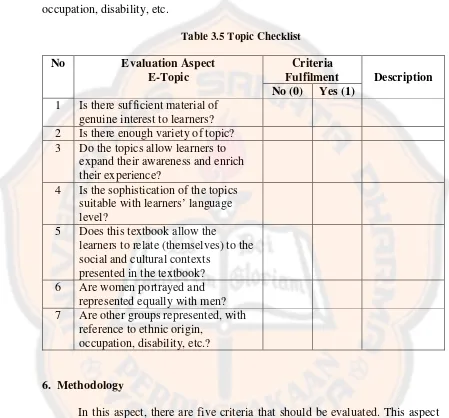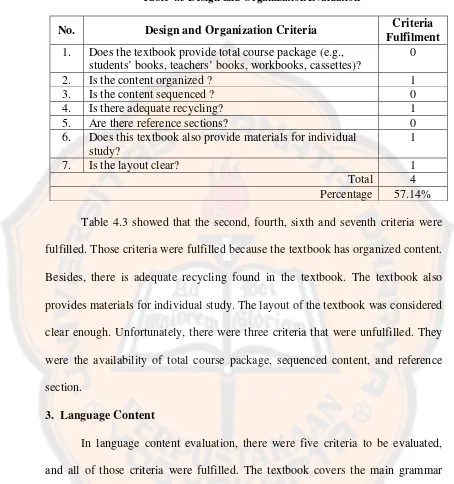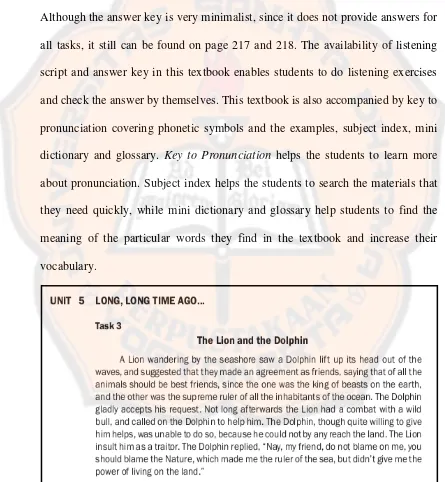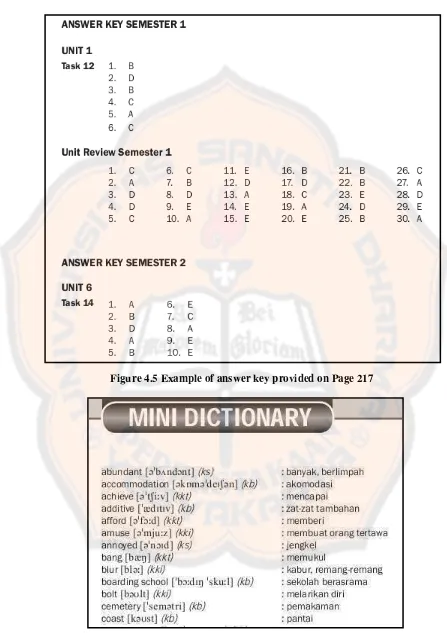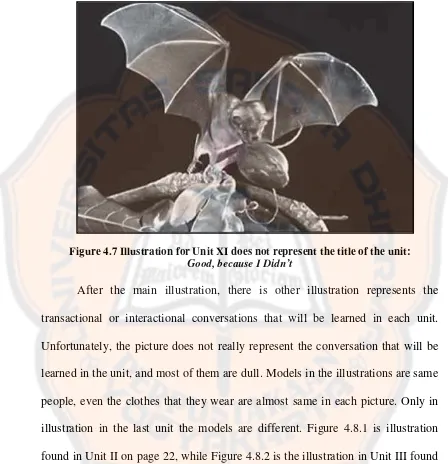vii ABSTRACT
Firiady, Maryska. (2013). A Content Analysis of the Textbook Interlanguage: English for Senior High School Students XI for Science and Social Study Programme. Undergraduate Thesis. Yogyakarta: English Language Education Study Program, Department of Language and Arts Education, Faculty of Teachers Training and Education, Sanata Dharma University.
Textbooks have very important roles in English language teaching and Interlanguage: English for Senior High School Students XI for Science and Social Study Programme in order to help the teachers to make the best use of the electronic English textbook provided by the government.
This research was collaborative research conducted together with two other researchers. There were two research questions in this research. The first was “Does Interlanguage: English for Senior High School Students XI for Science and Social Study Programme fulfil the criteria of a good textbook?” The second one was “What are strengths and weaknesses of the textbook?”
In nature this was qualitative research with document analysis as its method. The subject of this research was the textbook Interlanguage: English for Senior High School Students XI Science and Social Study Programme. The evaluation of the textbook was conducted by using a checklist adapted from Cunningsworth’s textbook evaluation checklist. There were eight aspects that were evaluated. Those aspects were aims and approaches, design and organization, language content, skills, topic, methodology, teachers’ books and practical considerations.
The results of the analysis showed two important findings. First, the textbook did not achieve good criteria fulfilment. The percentage of overall evaluation of this textbook was 63.92%, and therefore, it was categorized as fair textbook. Second, the main strengths of the textbook covered the language content and methodology aspects that were considered good fulfilment. Besides, this textbook provided materials for integrated skills and individual study, organized content and practical use. On the other hand, the main weaknesses of this textbook were the unavailability of supporting materials especially the teachers’ book and the recording of listening materials, the sequenced materials which were not really appropriate with genre-based principles and dull illustration.
viii ABSTRAK
Firiady, Maryska. (2013). A Content Analysis of the Textbook Interlanguage: English for Senior High School Students XI for Science and Social Study Programme. Skripsi Sarjana Pendidikan. Yogyakarta: Program Studi Pendidikan Bahasa Inggris, Jurusan Pendidikan Bahasa dan Seni, Fakultas Keguruan dan Ilmu Pendidikan, Universitas Sanata Dharma.
Buku teks mempunyai peran yang sangat penting dalam proses belajar mengajar Bahasa Inggris. Keberadaan buku teks sebagai salah satu sumber materi pembelajaran dapat sangat bermanfaat bagi para guru Bahasa Inggris. Terdapat banyak buku teks bahasa Inggris di pasaran, namun buku-buku teks tersebut belum tentu sesuai dengan kebutuhan setiap guru bahasa Inggris. Peran guru adalah memilih dan menyiasati buku teks yang ada. Maka, penelitian ini bertujuan untuk menganalisa kelebihan dan kekurangan dari Interlanguage: English for Senior High School Students XI for Science and Social Study Programme untuk membantu guru dalam menggunakan Buku Sekolah Elektronik bahasa Inggris yang disediakan oleh pemerintah.
Penelitian ini merupakan penelitian kolaboratif yang dilakukan bersama dua peneliti lain. Terdapat dua rumusan masalah dalam penelitian ini. Rumusan masalah yang pertama adalah apakah buku teks Interlanguage: English for Senior High School Students XI for Science and Social Study Programme memenuhi kriteria buku teks yang baik atau tidak. Rumusan masalah yang kedua adalah apakah kelebihan dan kekurangan dari buku teks tersebut.
Penelitian ini pada dasarnya merupakan penelitian kualitatif yang menggunakan metode analisa dokumen. Subyek dari penelitian ini adalah buku teks Interlanguage: English for Senior High School Students XI for Science and Social Study Programme. Buku teks ini dievaluasi dengan menggunakan checklist yang diadaptasi dari checklist milik Cunningsworth. Terdapat delapan aspek yang dievaluasi yaitu aims and approaches, design and organization, language content, skills, topic, methodology, teachers’ books dan practical considerations.
Analisa dalam penelitian ini menunjukkan dua hasil penting. Pertama, buku teks yang diteliti tidak memenuhi kriteria buku teks yang baik. Persentase dari hasil evaluasi keseluruhan terhadap buku teks ini sebesar 63,92%, sehingga dikategorikan sebagai fair textbook. Kedua, kelebihan utama buku ini mencakup terpenuhinya kriteria dalam aspek language content dan methodology yang dikategorikan mencapai good fulfilment. Selain itu, buku teks ini juga menyediakan materi yang terorganisir, mencakup integrated skill dan dapat digunakan untuk belajar mandiri. Kegunaan praktis juga menjadi kelebihan buku teks ini. Sebaliknya, kekurangan utama buku ini meliputi ketidaktersediaan materi pendukung terutama buku panduan guru dan rekaman materi Listening, materi yang tidak runtut serta tidak sesuai dengan prinsip genre-based approach, dan ilustrasi yang tidak menarik.
A CONTENT ANALYSIS OF THE TEXTBOOK
INTERLANGUAGE: ENGLISH FOR SENIOR HIGH SCHOOL
STUDENTS XI FOR SCIENCE AND SOCIAL
STUDY PROGRAMME
A SARJANA PENDIDIKAN THESIS
Presented as Partial Fulfillment of the Requirements to Obtain the Sarjana Pendidikan Degree
in English Language Education
By Maryska Firiady Student Number: 081214114
ENGLISH LANGUAGE EDUCATION STUDY PROGRAM DEPARTMENT OF LANGUAGE AND ARTS EDUCATION FACULTY OF TEACHERS TRAINING AND EDUCATION
SANATA DHARMA UNIVERSITY YOGYAKARTA
i
A CONTENT ANALYSIS OF THE TEXTBOOK
INTERLANGUAGE: ENGLISH FOR SENIOR HIGH SCHOOL
STUDENTS XI FOR SCIENCE AND SOCIAL
STUDY PROGRAMME
A SARJANA PENDIDIKAN THESIS
Presented as Partial Fulfillment of the Requirements to Obtain the Sarjana Pendidikan Degree
in English Language Education
By Maryska Firiady Student Number: 081214114
ENGLISH LANGUAGE EDUCATION STUDY PROGRAM DEPARTMENT OF LANGUAGE AND ARTS EDUCATION FACULTY OF TEACHERS TRAINING AND EDUCATION
SANATA DHARMA UNIVERSITY YOGYAKARTA
iv
The Serenity Prayer
The Serenity Prayer
The Serenity Prayer
The Serenity Prayer
God, grant me the serenity to accept the things I cannot change,
the courage to change the things I can,
and the wisdom to know the difference.
vii ABSTRACT
Firiady, Maryska. (2013). A Content Analysis of the Textbook Interlanguage: English for Senior High School Students XI for Science and Social Study Programme. Undergraduate Thesis. Yogyakarta: English Language Education Study Program, Department of Language and Arts Education, Faculty of Teachers Training and Education, Sanata Dharma University.
Textbooks have very important roles in English language teaching and Interlanguage: English for Senior High School Students XI for Science and Social Study Programme in order to help the teachers to make the best use of the electronic English textbook provided by the government.
This research was collaborative research conducted together with two other researchers. There were two research questions in this research. The first was “Does Interlanguage: English for Senior High School Students XI for Science and Social Study Programme fulfil the criteria of a good textbook?” The second one was “What are strengths and weaknesses of the textbook?”
In nature this was qualitative research with document analysis as its method. The subject of this research was the textbook Interlanguage: English for Senior High School Students XI Science and Social Study Programme. The evaluation of the textbook was conducted by using a checklist adapted from Cunningsworth’s textbook evaluation checklist. There were eight aspects that were evaluated. Those aspects were aims and approaches, design and organization, language content, skills, topic, methodology, teachers’ books and practical considerations.
The results of the analysis showed two important findings. First, the textbook did not achieve good criteria fulfilment. The percentage of overall evaluation of this textbook was 63.92%, and therefore, it was categorized as fair textbook. Second, the main strengths of the textbook covered the language content and methodology aspects that were considered good fulfilment. Besides, this textbook provided materials for integrated skills and individual study, organized content and practical use. On the other hand, the main weaknesses of this textbook were the unavailability of supporting materials especially the teachers’ book and the recording of listening materials, the sequenced materials which were not really appropriate with genre-based principles and dull illustration.
viii ABSTRAK
Firiady, Maryska. (2013). A Content Analysis of the Textbook Interlanguage: English for Senior High School Students XI for Science and Social Study Programme. Skripsi Sarjana Pendidikan. Yogyakarta: Program Studi Pendidikan Bahasa Inggris, Jurusan Pendidikan Bahasa dan Seni, Fakultas Keguruan dan Ilmu Pendidikan, Universitas Sanata Dharma.
Buku teks mempunyai peran yang sangat penting dalam proses belajar mengajar Bahasa Inggris. Keberadaan buku teks sebagai salah satu sumber materi pembelajaran dapat sangat bermanfaat bagi para guru Bahasa Inggris. Terdapat banyak buku teks bahasa Inggris di pasaran, namun buku-buku teks tersebut belum tentu sesuai dengan kebutuhan setiap guru bahasa Inggris. Peran guru adalah memilih dan menyiasati buku teks yang ada. Maka, penelitian ini bertujuan untuk menganalisa kelebihan dan kekurangan dari Interlanguage: English for Senior High School Students XI for Science and Social Study Programme untuk membantu guru dalam menggunakan Buku Sekolah Elektronik bahasa Inggris yang disediakan oleh pemerintah.
Penelitian ini merupakan penelitian kolaboratif yang dilakukan bersama dua peneliti lain. Terdapat dua rumusan masalah dalam penelitian ini. Rumusan masalah yang pertama adalah apakah buku teks Interlanguage: English for Senior High School Students XI for Science and Social Study Programme memenuhi kriteria buku teks yang baik atau tidak. Rumusan masalah yang kedua adalah apakah kelebihan dan kekurangan dari buku teks tersebut.
Penelitian ini pada dasarnya merupakan penelitian kualitatif yang menggunakan metode analisa dokumen. Subyek dari penelitian ini adalah buku teks Interlanguage: English for Senior High School Students XI for Science and Social Study Programme. Buku teks ini dievaluasi dengan menggunakan checklist yang diadaptasi dari checklist milik Cunningsworth. Terdapat delapan aspek yang dievaluasi yaitu aims and approaches, design and organization, language content, skills, topic, methodology, teachers’ books dan practical considerations.
Analisa dalam penelitian ini menunjukkan dua hasil penting. Pertama, buku teks yang diteliti tidak memenuhi kriteria buku teks yang baik. Persentase dari hasil evaluasi keseluruhan terhadap buku teks ini sebesar 63,92%, sehingga dikategorikan sebagai fair textbook. Kedua, kelebihan utama buku ini mencakup terpenuhinya kriteria dalam aspek language content dan methodology yang dikategorikan mencapai good fulfilment. Selain itu, buku teks ini juga menyediakan materi yang terorganisir, mencakup integrated skill dan dapat digunakan untuk belajar mandiri. Kegunaan praktis juga menjadi kelebihan buku teks ini. Sebaliknya, kekurangan utama buku ini meliputi ketidaktersediaan materi pendukung terutama buku panduan guru dan rekaman materi Listening, materi yang tidak runtut serta tidak sesuai dengan prinsip genre-based approach, dan ilustrasi yang tidak menarik.
ix
ACKNOWLEDGEMENTS
It is such a great and beautiful moment to struggle and finish writing this thesis. There are a lot of laughter, pain, experience and new insight that I found during the process I was working on this thesis. Therefore, I always feel thankful and grateful for the blessing of God who is so kind to help me pass all the process. Without the strength and guidance that He always gives to me, it would be impossible for me to reach this stage so far.
I would like to show my first gratitude to my advisor and research collaborator Carla Sih Prabandari, S.Pd., M.Hum. who has kindly and patiently guided, enlightened and encouraged me in writing this thesis. I also would like to thank my parents Wenny Sugiarti and Jap Sie Fie for everything they give to me. Without their love and faith in me, I would not be able to finish this thesis or even my study.
My next gratitude is for the other collaborator in this collaborative research, Adam Semitha for being a very good colleague, friend and motivator. I am pleased to work and learn together with him as well as I appreciate the opportunity and experience that we have during the process of writing this thesis.
x
Esther, Pita and Priska who have given me support and patiently answered all the questions that are related to this thesis.
xi
STATEMENT OF WORK’S ORIGINALITY ... v
PERNYATAAN PERSETUJUAN PUBLIKASI ... vi
ABSTRACT ... vii A. Theoretical Description……….. 8
1. Definition of Textbook………. 8
2. The Role of Textbook……….. 9
3. Textbook Evaluation……… 13
4. Textbook Evaluation Criteria……….. 15
xii
B. Theoretical Framework………... 32
CHAPTER III METHODOLOGY A. Research Method……… 35
B. Research Subject………. 37
C. Instruments and Data Gathering Technique……… 37
D. Data Analysis Technique……… 38
E. Research Procedure……… 47
CHAPTER IV ANALYSIS A. Textbook Evaluation……… 50
1. Aims and Approaches………. 52
2. Design and Organization………. 52
3. Language Content……… 53
B. Description of Strengths and Weaknesses of the Textbook 61 1. Aims and Approaches……… 61
2. Design and Organization……… 67
xiii
B. Suggestions……… 123
xiv
LIST OF TABLES
Table Page
3.1 Aims and Approaches Checklist ... 39
3.2 Design and Organization Checklist ... 40
3.3 Language Content Checklist ... 40
3.4.1 Skills Checklist ... 41
3.4.2 Listening Skill Checklist ... 41
3.4.3 Speaking Skill Checklist ... 42
3.4.4 Reading Skill Checklist ... 42
3.4.5 Writing Skill Checklist ... 43
3.5 Topic Checklist ... 44
3.6 Methodology Checklist ... 45
3.7 Teachers’ Books Checklist ... 45
3.8 Practical Considerations Checklist ... 46
3.9 Categorization of the Criteria Fulfilment ... 47
4.1 Evaluation Summary Table ... 51
4.2 Aims and Approaches Evaluation ... 52
4.3 Design and Organization Evaluation ... 53
4.4 Language Content Evaluation ... 54
4.5.1 Skills Evaluation ... 54
4.5.2 Listening Skill Evaluation ... 55
4.5.3 Speaking Evaluation... 56
4.5.4 Reading Evaluation ... 56
4.5.5 Writing Evaluation ... 57
4.6 Topic Evaluation ... 58
4.7 Methodology Evaluation ... 59
4.8 Teachers’ Books Evaluation ... 60
xv
LIST OF FIGURES
Figure Page
4.1 Mind map can be helpful for visual learners ... 64
4.2.1 The new vocabularies presented in Task 15 ... 69
4.2.2 New vocabularies in Task 15 are recycled in Task 16 ... 70
4.2.3 New vocabularies in Task 15 are recycled in Task 17 ... 70
4.3.1 Some examples of connectives are presented in Unit III on page 52 ... 71
4.3.2 Some of the connectives on page 52 are recycled on page 72 ... 71
4.4 One example of listening transcripts on page 208……… 72
4.5 Example of answer key provided on Page 217………. 73
4.6 Mini dictionary provided on page 220……… 73
4.7 Illustration for Unit XI does not represent the title Good, because I Didn’t 76 4.8.1 Example of illustration on page 22……… 77
4.8.2 The models in the illustration, and even their clothes are mostly same as illustrations in other units……….. 77
4.9 Example of grammar item………. 80
4.10 Examples of vocabulary exercise in the form of a crossword……… 81
4.11 Example of pronunciation material on page 10……….. 82
4.12 Vocabulary exercise is accompanied by phonetic transcription………… 83
4.13 One examples of reading passages that showed coherence, paragraphing and using of conjunctives and pronouns ... 84
4.14 Example of explanation of a narrative text………. 85
4.15 Differentiation of expressions used in formal and informal situation……. 86
4.16 Example of integrated activities……….. 88
4.17 Example of questions for listening skill which can help comprehension... 90
4.18 Example of activity for listening skill which can help comprehension….. 91
4.19 The example of instruction in listening materials which is not accompanied by any background information……… 92
4.20.1 Task 4 on page 5 does not have any link with Task 5……….. 94
xvi
4.21 Written activity in spoken cycle……….. 97
4.22 The passages are sometimes accompanied by small pictures………. 98
4.23 Example of different reading passage format………. 99
4.24.1 The example of controlled writing activity………. 102
4.24.2 Example of less controlled writing activity: It should be placed after Task 26………... 103
Figure 4.24.3 The example of controlled writing activity: It should be placed before Task 25………. 103
Figure 4.25 Example of By the Way……… 109
Figure 4.26 Example of Cultural Tips……… 109
Figure 4.27 Example of Intermezzo………. 109
xvii
LIST OF APPENDICES
Appendix Page
1. Standard Competence and Basic Competence for Grade XI………. 127
2. Interlanguage: English for Senior High School Student XI for Science and Social Study Programme Textbook Evaluation………... 135
3. Printed pages of Interlanguage……… 157
3.1 The cover of Interlanguage textbook for eleventh-graders………... 157
3.2 Unit Review Semester 1……… 158
3.3 Unit Review Semester 2……… 159
3.4 Pictures provided in Let’s Get ready for helping visualization……… 160
3.5 Chart provided in reading for helping visualization………. 161
3.6 Organization of textbook: Let’s Get Ready……… 162
3.7 Organization of textbook: Let’s Act: Listen and Speak……… 163
3.8 Organization of textbook: Let’s Act: Read and Write………... 164
3.9 Organization of textbook: Let’s Do More……….. 165
3.10 Organization of textbook: Let’s Check Your Competence……… 166
3.11 Organization of textbook: Let’s Make a Reflection………. 167
3.12 Organization of textbook: Let’s Make a Summary……… 168
3.13.1 Example of vocabulary recycling firstly in Task 11……….. 169
3.13.2 Example of vocabulary recycling secondly in Task 15……….. 170
3.13.3 Example of vocabulary recycling thirdly in Task 15………. 171
3.14 Listening scripts………. 172
3.15.1 Key to Pronunciation………. 173
3.15.2 Key to Pronunciation (continuous from previous page)………. 174
3.16 Subject Index……….... 175
3.17 Mini Dictionary……….. 176
3.18.1 Glossary……….. 177
3.18.2 Glossary (continuous from previous page)………. 178
xviii 3.19.2 Comparison of Unit II and Unit X:
Clear layout and consistent heading, font and icon (Unit X)……….. 180
3.20 Each unit is opened with the name of the unit, the title of unit and an opening illustration………. 181
3.21.1 Comparison of illustration in Unit I and Unit IV: The same models makes there is no variation in illustration (Unit I)…………. 182
3.21.2 Comparison of illustration in Unit I and Unit IV: The same models makes there is no variation in illustration (Unit IV)……….. 183
3.22 Other supporting illustration is small and uninteresting………. 184
3.23 Example of grammar materials in Task 15………... 185
3.24 Example of grammar exercise in Task 16………. 186
3.25 Example of Vocabulary material before reading passage……… 187
3.26 Example of pronunciation materials in Task 8 and Task 9………. 188
3.27 Example of convention of a text in Task 18………... 189
3.28 Example of expressions used in formal and informal situation………….. 190
3.29 Example of integrated material in Task 14………. 191
3.30 Example of questions which accompany listening materials……….. 192
3.31 Example of listening activity which accompanies listening material in Task 6………. 193
3.32 Listening instruction is not accompanied by background information which can help comprehension……….. 194
3.33 The sequence between activities is not really connected since there are two focused materials………..195
3.34 There is written activity which is more appropriate for reading in spoken cycle………. 196
3.35 Example of a reading passage accompanied by small picture, list vocabulary and questions……….. 197
3.36 Example of a reading activity: Rearranging jumbled paragraph in Task 21……… 198
3.37 Example of controlled writing activity………... 199
xix
3.39 Lack of less controlled writing activity in Read and Write Part………… 201 3.40 Example of topic: Global warming……… 202 3.41 Example of topic: Love stories……….. 203 3.42 Additional part: By the Way……….. 204 3.43 Additional part: Cultural Tips……… 205 3.44 Additional part: Intermezzo……….. 206 3.45 Story from other country……….... 207 3.46 Illustration of a woman who is crying,
1 CHAPTER I INTRODUCTION
This chapter is an introductory part of this thesis. There are six sections in this chapter. Those sections provide the readers with information about the research background, research problem, problem limitation, research objectives, research benefits and definition of terms.
A. Research Background
This research is conducted as the concern for the importance of textbook quality in language teaching. Brown (2007) says that material in various forms such as books, pictures, charts, realia and technological aids is so crucial that language classes cannot be without it (p. 187). Textbook as one form of materials plays important role in the language teaching. Brown (2007) also states that “the most obvious and most common form of material support for language instruction comes through textbooks” (p. 188).
In relation to application of School Based Curriculum or Kurikulum Tingkat Satuan Pendidikan (KTSP) in Indonesia, teachers are free to modify teaching learning activities and materials based on students’ need in the classroom. The teachers can use a textbook as a primary source of materials or prepare their own materials from many sources like other reference books and internet. However, Graves (2000) notes that “a majority of teachers don’t have the time or resources to prepare their own materials” (p. 173). Besides, the materials should be appropriate to the competence standards and basic competences in the curriculum. The existence of a reliable source of materials that is appropriate to the competence standards and basic competences in the curriculum can help the teachers to provide qualified materials for their students.
The government has actually provided materials for English language teaching in Indonesia. The materials are provided by the government in the form of electronic textbooks that can be accessed and downloaded freely from http://bse.kemdiknas.go.id. These textbooks are known as Buku Sekolah Elektronik or BSE. The English textbooks named Interlanguage and Developing English Competencies are provided for ten, eleven and twelve grade students of senior high school.
textbooks for school, e-textbook policy was implemented. The basis of this implementation was the assumption that technology can support learning.
The arrangement of the English textbooks should also be adjusted to the School Based Curriculum. In the preface of Interlanguage: English for Senior High School Students XI for Science and Social Study Programme, the writers of the textbook consisting of Priyana, Riandi and Mumpuni (2008) mention that the content of the textbook is adjusted to standards of competence for English lesson 2006. Besides, the learning tasks in the textbook are developed based on the principles of communicative approach in order to develop students’ competence in listening, speaking, reading and writing in an integrated way. However, further evaluation is still needed in order to maintain the quality of the textbook and to make sure that it is worth to be used.
Textbook evaluation is a common thing done to improve the quality of a textbook. According to Mukundan (2007), “The evaluation of textbooks is considered an important activity in the lives of the English teacher” (p. 80). It is also done to select the most appropriate textbook to be used in the classroom or to provide feedback for revision.
content of Interlanguage: English for Senior High School Students XI for Science and Social Study Programme. as one of the electronic textbooks provided by the government is qualified or not. This research is also aimed to find out the strengths and weaknesses of the textbook. It is expected that positive feedback given through this research can be beneficial to help the English teachers in using the textbook and to improve the quality of the textbook provided by the government.
B. Research Problem
The research problem that the researcher wants to investigate is the following questions:
1. Does Interlanguage: English for Senior High School Students XI for Science and Social Study Programme textbook fulfil the criteria of a good textbook? 2. What are strengths and weaknesses of the textbook Interlanguage: English for
Senior High School Students XI for Science and Social Study Programme?
C. Problem Limitation
textbook are adapted from the Cunningsworth’s textbook evaluation checklist. This research focuses on whether the content of the analysed textbook fulfils those criteria or not. The strengths and weaknesses of the textbook are also evaluated based on those criteria. There are eight aspects that will be analysed. Those aspects are aims and approaches, design and organization, language content, skills, topic, methodology, teachers’ books and practical considerations.
.
D. Research Objectives
The aim of this research is to answer the proposed research questions. Therefore, the research objectives are:
1. To find out whether Interlanguage: English for Senior High School Students XI for Science and Social Study Programme fulfils the criteria of a good textbook or not.
2. To find out what the strengths and weaknesses of the textbook Interlanguage: English for Senior High School Students XI for Science and Social Study Programme are.
E. Research Benefits
The researcher expects that this research can be beneficial for English teachers, the textbook writers, and future researchers as elaborated as follows. 1. For English teachers
textbook can be easily accessed and downloaded, it actually can be used as the preferable source of materials. Besides, knowing the strengths and weaknesses of the textbook can help the teachers in using the textbook. Additionally, the teachers may gain knowledge about principles in a textbook evaluation. It may help the teacher to decide or to evaluate a textbook that will be used in their class.
2. For the textbook writers
It is expected that the results of this research can give textbook writers feedback to improve the quality of English textbooks. Making improvement on the quality of the English textbooks is important to improve the quality of education in Indonesia. It is very important to control and maintain the quality of the English textbooks, especially for the ones that are provided by the government. Thus, the electronic English textbook can truly become an easy accessed and recommended source of materials both for the teachers and the students.
3. For the future researchers
Hopefully this research is also beneficial for other researchers. The researcher hopes that the results of this research can be useful for those who want to conduct similar research. Future research can help provide this research with positive feedback for the sake of improvement.
F. Definition of Terms
1. Content analysis
In this research, content analysis briefly can be defined as an analysis of written or visual materials. This analysis is done in order to identify particular characteristics of the materials (Ary, Jacobs, Sorensen and Razavieh, 2002). In this research, the material that will be analysed is a textbook.
2. Textbook
The definition of a textbook in this research refers to a book used in English language teaching and learning which provides learners with a basis of language input and language practices. It may include the basis for the content of the lessons, the balance of skills taught and the kinds of language practice. Thus, it helps the teachers to provide ideas in planning and teaching lessons (Richards, 2012).
3. Interlanguage: English for Senior High School Students XI for Science and Social Study Programme
8 CHAPTER II
REVIEW OF RELATED LITERATURE
This chapter discusses the theories that underlie this research. This chapter is subdivided into two parts. The first part is theoretical description, and the second part is theoretical framework.
A. Theoretical Description
There are five main issues that the researcher wants to discuss as the underlying theories for this research. They are definition of textbook, the role of textbook, textbook evaluation, textbook evaluation criteria, and genre based approach.
1. Definition of Textbook
2. The Role of Textbook
Using a textbook brings both advantages and disadvantages to teachers. Some experts like Gebhard (1996), Graves (2000), Richards (2001) and Brewster, Ellis and Girard (2004) have discussed this issue by mentioning the advantages and disadvantages of using a textbook. However, they agreed that the availability of a textbook is beneficial and important for the teachers, despite the fact that it also brings disadvantages.
Gebhard (1996) mentions two advantages of using a textbook. The first is that using textbook can save teachers’ time. The second is that a textbook can be teaching materials functioning as guidance that takes the teacher and students through the lessons systematically. Graves (2000) also agrees that using a textbook can save teachers’ time. She says that what a textbook provides such as visuals, activities, reading, etc. help teachers in finding or developing materials, and thus it saves teachers’ time. Besides, she also mentions that a textbook provides syllabus for the course, basis for students’ assessment, consistency between level, supporting materials and security for the students. The students feel secure since they know the road map of the course. Therefore, they know exactly what to expect and what is expected from them. Graves (2000) concludes that a textbook may provide all what are needed by teachers from materials until evaluation.
mentions eight principal advantages for using a textbook. First, textbooks can be a representation of a syllabus of the language program. Second, using textbooks can help to make sure that the students get similar materials and assessment. Third, the materials of textbooks usually are more reliable since they have been tried and tested. Fourth, textbooks are usually accompanied by supporting materials such as workbooks, CDs, cassettes, videos, CD-ROMs and teaching guides. Fifth, using textbooks is efficient. Sixth, textbooks can be models of language input for teachers especially for those whose first language is not English. Seventh, textbooks accompanied by teacher’s manual can be guidance for teachers who have limited teaching experience. Eighth, since textbooks usually are well-designed, they are attractive for learners and teachers.
Together with Gebhard (1996) and Graves (2000), Richards (2001) agrees that using a textbook is efficient. It provides the teachers with some features such as syllabus and resources that will help them to teach in the class. Therefore, the teachers can devote their time more in teaching rather than in producing the materials.
Brewster, Ellis and Girard (2004) add some other reasons for using a textbook. They not only agree that the textbook can provide resources for teachers and can reduce their workload, but also say that a textbook is a useful aid for learning. It helps both the teacher and the student to know what should be taught and learned as well as the methodology and the order to do it.
Richards (2001) and Brewster, Ellis and Girard (2004) have stated some of good reasons for using a textbook. All of those experts agree that the textbook can help reduce the teachers’ workload by providing guidance of what should be taught, plus the materials needed. Thus, it also saves the teachers’ time and provides more opportunity for the teachers to focus on their teaching.
Despite the advantages, it cannot be denied that a textbook also brings disadvantages to the teachers. Indeed, a language teaching and learning process always depends on situations which happen in the classroom and backgrounds of the students. Therefore, probably there would be no perfect textbook for each teacher that can suit all the needs in each class. Richards (2001) mentions that since a textbook is made for general market, they may not suitable for every learner. Graves (2000) also warns that one of the weaknesses of using a textbook is that “the content or examples may not be relevant or appropriate to the group you are teaching” (p. 174).
and as a result they lose the control of classroom and awareness to respond and provide feedback for their students.
However, many language teaching experts still believe in the benefits and importance of the availability of a textbook. The fact that a textbook brings many benefits to the teachers makes a lot of teachers prefer to use a textbook in their teaching. Skierso (1991) mentions “No teacher is entirely satisfied with the text used, yet very few manage to teach without one” (p. 432). There are many teachers who still decide to use a textbook for its benefits.
Facing the pros and cons of using textbook, Graves (2000) states that “the textbook is a stimulus or instrument for teaching and learning” (p. 175). Therefore, a textbook should be a tool that helps the teachers in teaching, and should not be the teacher itself. The textbook should be used wisely and carefully by the teachers. Crawford (2002) mentions that it is the problem of balance. It means that the teachers should be aware of both the positive and negative sides of using a textbook.
Based on the elaboration above, focusing on the good sides of the textbook, Harmer (2007) shows that textbook should not be something harmful for teachers. On the other hand, it can be a good partner for the teachers as long as they use it wisely. “We are using coursebook’s strength but marrying them with our own skills and perceptions of the class in front of us” (Harmer, 2007:146).
3. Textbook Evaluation
Since the textbook has a lot of advantages, it can be considered as an important tool for teachers. However, there are a lot of textbooks that teachers can choose. Sometimes the selection process can be confusing. Richards (2001) argues that since there are many published commercial textbooks and the other form of instructional materials, teachers are expected to make judgments about the textbook and other teaching materials.
Textbook evaluation can be seen as a way to see and to analyse the content of a textbook. It can help teachers to select the most appropriate textbook to be used in their classroom. One reason or aim for evaluating textbook is to provide feedback for revision (Mukundan, 2007). Therefore, a process of textbook evaluation can also be done to improve the quality of the textbook.
the very general evaluation done quickly by only looking through the textbook. After that, a prediction of the textbook’s strengths and weaknesses is made.
The impressionistic overview is useful for giving general introduction of the content of the textbook, but it may not give detailed information about the textbook. Furthermore, Cunningsworth (1995) explains the weaknesses of the impressionistic overview as follows.
It will not necessarily identify any significant omissions in the coursebook or locate any important weakness. Nor it can be relied on to give enough detail to ensure good match between what coursebook contains and the requirements of the teaching/learning situation (Cunningsworth, 1995:1). On other hand, in-depth examination of textbook can provide teachers with more specific information that are related to the teaching learning activities. Different more aspects such as the aims of the course and language content can also be evaluated (Cunningsworth, 1995).
The best thing to do is probably combining both of these impressionistic overview and in-depth examination. Cunningsworth (1995) mentions that combination of an impressionistic overview of the whole and in-depth examination of representative samples of the materials will help to find the most suitable textbook. Thorough evaluation done through impressionistic and in-depth examination can help provide both the teacher and the student the most suitable textbook to be used in the classroom.
the textbook. In-use evaluation is done when the materials or the textbook is being used. The aim of this evaluation is to monitor a newly introduced textbook or to seek consideration for replacement of ageing textbooks. Post-use evaluation is done after the textbook is used. This evaluation is useful in deciding whether the textbook will be used in the following language course or not.
4. Textbook Evaluation Criteria
Textbook evaluation usually involves a checklist in analysing whether the textbook has fulfilled certain criteria or not. The criteria may vary based on teacher’s need. However, Cunningsworth (1995) proposes that in order to gain practical purpose, it is important to manage a list of the most important criteria. Brown (2007), Skierso (1991), Cunningsworth (1995), Byrd (2001) and Harmer (2007) have proposed kinds of checklist to evaluate textbook.
second analysis toward the teacher’s manual includes some aspects like general features, supplementary exercises for each language skill, methodological and pedagogical guidance, and linguistic background information. The analysis on overall value covers overall suitability, appropriacy, adequacy, and effectiveness.
The other textbook evaluation checklist is proposed by Byrd (2001). She says that the matter needs to be considered in textbook evaluation is the fit between the textbook with the curriculum, the students and the teachers. Therefore, their checklist is arranged by dividing the checklist into four aspects. These four aspects are the fix between the textbook and the curriculum, the fix between the textbook and the students, the fix between the textbook and the teachers, and overall evaluation of the fit of the textbook for the course in the program.
Harmer (2007) also contributes a checklist for evaluating textbook. There are ten aspects which are evaluated in Harmer’s checklist. The aspects of the checklist include price and availability, add-ons and extras, layout and design, instructions, methodology, syllabus, language skills, topics, cultural appropriacy and teacher’s guide.
facilitate learners’ need through learning processes that do not impose certain method. The last, it should have a role as a mediator between the target language and the learner. These criteria are developed into a checklist that is organized into some aspects. The aspects covered in Cunningsworth’s checklist are aims and approaches, design and organization, language content, skills, topic, methodology, teachers’ book and practical considerations. The elaborations of the criteria in the eight aspects which are proposed by Cunningsworth (1995) are as follows.
a. Aims and Approaches Criteria
some choice in the way the learn” (p. 16). Additionally, Felder and Henriques (1995) define the term learning style as the way of an individual obtains information. They note that in language instruction, people mostly obtain sensory information in visual and verbal. The visual learners prefer visually presented materials, while verbal learners prefer spoken and written explanations. Felder and Henriques (1995) claim that “presenting the same materials in different ways invariably has a reinforcing effect on retention” (p. 24). Therefore, they suggest providing verbal classroom presentation with non-verbal visual materials such as photographs, drawings, sketches and cartoons to reinforce presentation of vocabulary words, and using films, videotapes, and dramatization to illustrate lessons in dialogue and pronunciation.
b. Design and Organization Criteria
The second aspect is design and organization. Brown (2007) also suggests evaluating this aspect by including sequencing and format aspects in his checklist. Skierso (1991) includes layout and physical aspect in her checklist, while Harmer (2007) includes layout and design aspect in his checklist.
is well organized or not. It is suggested to check whether it is easy to follow the logic of the materials and to find the way around the page or the unit quickly and easily. Additionally, Cunningsworth (1995) advises that “a basic principle of learning is to move from the familiar to the new, and to relate new items to those already known” (p. 28). Riddell (2003) states that “the language covered should have a logical progression (starting the book at one level, but finishing it at a higher level)” (p. 205). Therefore, the materials usually should be presented from the easy ones to the difficult ones.
Cunningsworth (1995) also suggests checking whether the textbook provides adequate recycling or not. He explains that “In the case of grammar and vocabulary, items not only need to be met in context and actively practiced, they need to be recycled three, four or more times before they become stored in the long-term memory (p. 28). In other words, he suggests that grammar and vocabularies items should be recycled in order to make the students memorize them better. Furthermore, Cunningsworth (1995) also advises to check whether there are reference section and materials for individual study or not. He mentions that a textbook should “offer its content for selection on a ‘self-service’ basis” (p. 30).
states that a textbook should “be visually attractive and well laid out-clear and easy to follow” (p. 205).
c. Language Content Criteria
The third aspect is language content. Skierso (1991) also notes evaluation of vocabulary and structures aspect in her checklist. In this aspect, the materials which are related to grammar, vocabulary, pronunciation, style and appropriacy are evaluated. Riddell (2003) defines grammar as “language and how we use it; tenses are just a fraction of our language” (p. 29). Indeed, the term grammar refers to rules of language, but he adds that teaching grammar is not merely teaching tenses or verb forms. Cunningsworth (1995) mentions that consideration in evaluating grammar covers “what grammar items are included and how far they correspond to learner needs” (p. 32).
In relation with evaluating vocabulary of the textbook, Riddell (2003) states that teachers “may need to teach words required for the reading or listening coming up later–but only the essential words that the students will need to complete the task(s)” (p. 60). Therefore, Riddell advises to put focus on the vocabulary that is needed to complete listening and reading tasks. Furthermore, Cunningsworth (1995) advises that it is not expected to just have the list of the new words with their dictionary definition. It is important to keep the vocabulary being learned inside of context.
adds the benefit of phonetic transcription. He mentions that phonetic transcription as the representation of the sounds of English is what students need as a guide.
The next criterion to be evaluated is related to discourse competence. Cunningsworth (1995) defines the term discourse as
a general way to refer to the features of language use that go beyond the domain of grammar rules and include areas such as the sequencing of sentences, cohesion, paragraphing, structuring text, participation in conversations, etc (p. 45).
He also states that consciously or subconsciously, the models of discourse are presented in the textbooks as there are examples of language use in dialogues, reading texts and listening passages. What makes them different is the range and complexity of the examples. Furthermore, Cunningsworth (1995:46) explains that in a reading text, there should be display of features of authentic text, such as coherent structuring of content, paragraphing and appropriate use of cohesive devices, including pronouns for anaphoric reference and conjunctives. In the examples of dialogues or listening, there should be model of natural spoken English and turn-taking. In writing, there are materials on organizing different kind of written work such as narratives, reports, letters, etc. and there should be explanation on the conventions of the formats.
using the language, it is important to differentiate social situations and match the language style to those situations.
d. Skills Criteria
The fourth aspect is skills. In this aspect, how the materials are developed to improve students’ skill is evaluated. This aspect also appears both in Brown’s (2007) and Harmer’s (2007) checklist. Cunningsworth (1995) mentions that it is necessary to check in what way the textbook deals with listening, speaking, reading and writing skills. It is also important to check whether the textbook “deals adequately with all four skills, taking the level and overall aims into account, and if there is a suitable balance between the skills” (p. 64). Then, he adds that “the integration of skills is an important aspect of overall language ability” (p. 65).
asking questions about the detailed information of the passage, and the fifth stage is having follow-up activity based on the topic.
In evaluating materials for speaking skill, Cunningsworth (1995) reminds teachers to evaluate the effectiveness of the materials in equipping the students for real-life interactions. Cunningsworth (1995) mentions that “Speaking practice takes place through the oral presentation and practice of new language items, in dialogue work and in roleplay” (p. 69). Moreover, he also adds that an information gap activity is good for speaking practices.
In relation to reading material evaluation, Cunningsworth (1995) advises that reading passages should be interesting, authentic, well-presented and completed with activities that can help reading process. The quantity of the reading materials should also be considered. Since the textbook is made for general market, choosing an interesting topic is not easy. It is necessary to consider that the topic is culturally acceptable. He adds that “the presentation of topic is also important and the use of different type-faces, simulated or real newspaper formats, colour blocks, etc can make the reading passage stand out of something special with its own identity” (p.75).
students be familiar with the way how a written text is organized including the convention of a text. Besides, it should deal with paragraphing and make the students aware to use appropriate style in writing.
e. Topic Criteria
The fifth aspect is topic. Topic aspect covers evaluation of the topic found in the textbook. This aspect also appears in Harmer’s checklist (2007). Cunningsworth (1995) mentions that a textbook must represent a language use in real situation for real purpose, and therefore it should deal with various kinds of topics. He also suggests that “at whatever level, topics which are real and immediate must command more interest and response from learners than imaginary, made-up content” (p. 86). In addition, Cunningsworth (1995) states that “the content does not necessarily have to be heavy and intellectual in order to be worthwhile: there is plenty of scope for humour and human interest stories too (p. 88). Riddell (2003) then adds that higher level students can deal with more tough provoking issues such as technology since they have more language capability to talk about that.
In relation to social and cultural values, Cunningsworth (1995) mentions that it is necessary that a textbook includes social and cultural contexts in terms of location, social mores, age group, etc. He also suggests evaluating how the women are portrayed in the textbook. Cunningsworth (1995) mentions the aims of this such analysis is
Besides, Cunningsworth (1995) also suggests evaluating how the textbook represents people according to their ethnic origin, occupation, age, social class and disability.
f. Methodology Criteria
The sixth aspect is methodology aspect. This aspect is related to how the method of the materials is evaluated. This aspect also appears in Harmer’s checklist (2007). Cunningsworth (1995) mentions that implicitly it is clear that the textbook requires students to have role in the learning process. In order to facilitate that, the textbook should provide provision of material suitable for individual study. The material can be in the form of a workbook, reading materials or self-study cassettes. It is also necessary that the guidance on how to use those materials including cross-referencing from the main course to the workbook and key exercises are given so that the students can check their progress by themselves.
In relation to development of communicative abilities, Cunningsworth (1995) mentions that
It is open question to what extent coursebook can include real communicative activities, but at most levels it is possible to include realistic activities, often based on contrived information gaps of various kinds, which involve, at least language use which is communicative in the context of the classroom (p. 117).
It means that activities for developing students’ communicative abilities can be various. However, they should facilitate language use which is realistic and communicative in the context of classroom. The examples of activities mentioned by Cunningsworth are jigsaw reading and jigsaw listening.
Natalie Hess, (2001:159-160) says that “teaching of course ultimately depends on the willingness of the student to learn: unless the learner takes some responsibility in the shape of active cooperation and effort, there will be no learning in spite of the efforts of excellent teachers.” She mentions some ideas that may help the students focus on their study. The first is by giving sample questions before test and to let the students discuss it. The second, is by eliciting students’ concern on language learning at the beginning of the task, the third is by allowing students making a guide before test, and the forth by letting students writing their expectation of the course.
is showing the way of using reference skills such as how to use dictionary and grammar books.
g. Teachers’ Books Criteria
The seventh aspect in the checklist is teachers’ books. In this aspect, the availability and the content of the teacher’s book are evaluated. This aspect appears in Robinett’s (1991), Harmer’s (2007) and Skierso’s (1991) checklist. Even Skierso (1991) provides detailed evaluation to evaluate the content of the teacher’s manual.
According to Cunningsworth (1995), teachers’ books are very important because they can affect how the course is taught. He says that “a good teacher’s book is invaluable in offering, among other things, guidelines on how to make the best use of the course, detailed plans for teaching each unit and key to exercises” (p. 112). He also says that the teachers’ books should meet the needs of the users and also be flexible. He adds that “we should therefore check that the teacher’s book provides suggested procedures for planning, preparation and teaching of lessons” (p. 114).
h. Practical Considerations Criteria
the strength of the textbook also need to be considered. It is also necessary to check whether the supply of the textbook can be obtained easily. In selecting textbook with its accompanying materials such as listening recording and video, it is also important to check whether the equipment are reliable, available and ready to be used.
5. Genre Based Approach
Nowadays, Indonesia uses 2006 curriculum which is commonly known as Kurikulum Tingkat Satuan Pendidikan (KTSP) or school based curriculum. In this curriculum, the standards of competence for Senior High School level deal with various kinds of genres. The term genre can be simply defined as text type (Derewianka, 2003). There are various types of texts that should be learned in senior high school such as narrative, report, analytical exposition, etc (Basic competences of Senior High School). Since this curriculum deals with learning through texts, the application of genre theory should also get attention.
Australia has provided students with explicit knowledge about language. Besides, it also concerns for clear identification of what is to be learned and what is to be assessed. The third assumption is that the language learning process is a series of scaffolded developmental steps which deals with different aspects of language. Genre approach includes joint construction and scaffolding process which support learning progress through independent performance and potential performance which is gained through social interaction with the teacher or other students (Feez and Joyce, 2002: 26-29).
Derewianka (2003) also mentions some principles about genre theory which are relevant in educational context. She says that genre based approach emphasizes on meaning creation at the whole text level. Its goal is to achieve social purposes which focus on communicative competence such as shopping for food or telling the doctor about an illness. She also says that in genre approach “language is learned through guidance and interaction in the context of shared experience” (Derewianka, 2003). Therefore, Derewianka (2003), Feez and Joyce (2002) seem to agree that besides focusing on texts, genre based approach aims at social communicative competence. The learning is done through social interaction.
modelling and deconstructing the text, join construction of the text, independent construction of the text and linking to related texts.
Feez and Joyce (2002) explain that in the stage of building the context, the students are introduced to the particular authentic model of text type and its social context. The students explore features of general cultural context as well as the social function of the text. The activities that can be done in this stage include presenting context through pictures, audio-visual material, realia, excursions, field-trips, or guest speaker, establishing the social purpose through discussion or survey, doing related research activities and comparing the model text with other texts.
According to Feez and Joyce (2002), the next stage after building the context is stage of modelling and deconstructing the text. They explain that modelling stage involves exploration toward structural pattern and language features of the model text and comparison with the model of other texts. The examples of activities in this stage include presentation and practice activities that are related to the grammatical features.
Feez and Joyce (2002) explain that in a stage of independent construction of the text, students work independently with the text. Learner performances are used for achievement assessment. The examples of activities for listening tasks are comprehension activities in response to live or recorded material such as performing a task, sequencing pictures, numbering, ticking or underlining material on a worksheet and answering questions. The example of speaking task activity is spoken presentation to class, while the example of listening and speaking activities are role plays and simulated or authentic dialogues. Reading task activities include performing a task, sequencing pictures, numbering, ticking or underlining material on a worksheet, and answering questions. Meanwhile in writing, it is expected that the students draft and present whole texts in writing tasks.
The last stage is named linking to related texts. According to Feez and Joyce (2002), in this stage students investigate the comparison of what they have learned in the cycle with the other texts or teaching learning cycle. The activities in this stage are comparing the use of different text type, researching other text-type, role playing what happens if the same text type is used by people with different roles and relationships, comparing spoken and written models of the same text-type, and researching how a key language feature used in this text-type is used in other text types.
In relation to the teaching learning cycle, Derewianka (2003) gives a positive comment of it. She says that
In the early phases, the teacher takes a more direct role in developing the necessary knowledge and skills, with the learners in an ’apprentice’ role. As the learners develop greater control of the genre, the teacher gradually withdraws support and encourages learner independence (Derewianka, 2003:146).
The implementation of curriculum cycle is useful since it not only provides the students with sufficient guidance from the teacher but also evokes the student’s independent learning.
B. Theoretical Framework
After knowing the significance of a textbook in language teaching and the way to evaluate it, the researcher decided to conduct this textbook evaluation. In this research, impressionistic and in-depth examinations were done in order to get detailed evaluation of the textbook. This was pre-use evaluation which aimed to look for potential use of the textbook. The checklist used in this research was taken and adapated from Cunningswoth’s textbook evaluaation checklist (Cunningsworth, 1995). Before deciding to use this checklist, the researcher had also viewed and compared the checklists from other experts like Brown (2007), Skierso (1991), Byrd (2001) and Harmer (2007). Finally, it was decided to use Cunningsworth’s checklist.
evaluated based on specific students’ characteristic and situation of teaching learning in the classroom were avoided. However, the completeness and the depth of each checklist were also considered by the researcher.
The evaluation aspects covered in Cunningsworth’s checklist are almost similar to some aspects covered in Brown’s (2007) and Harmer’s (2007). Each of those checklists covers criteria to evaluate goals or aims of the course, language skills, format and layout, cultural appropriacy, and teacher’s guide. However, the elaboration of Cunningsworth’s checklist provides more detailed significant evaluation such as the authenticity of recording material for listening, the evaluation toward the amount of reading passages and the investigation of the completeness of the textbook including the reference section as well as the availability of the accompanying materials. Moreover, Cunningsworth (1995) elaborates most of criteria in his checklist.
The criteria in the skills aspect were divided into criteria of listening, speaking, reading and writing in order to make them more organized. Moreover, additional criteria whether the activities of each skill have already arranged based on genre based principles were added into the checklist. Such questions were added in relation to the application of school based curriculum which should involve the implementation of genre theory.
35 CHAPTER III METHODOLOGY
In this chapter, the researcher explains the methodology that is used in this research. This chapter covers research method, research subject, instrument and data gathering technique, data analysis technique, and research procedure.
A. Research Method
In nature this was qualitative research. Fraenkel and Wallen (2009) mention that “research studies that investigate the quality of relationships, activities, situations, or materials are frequently refered to as qualitative research” (p. 422). In addition to that, there are general characteristics of qualitative research that are proposed by Fraenkel and Wallen (2009). Fraenkel and Wallen (2009) say that qualitative researchers are concerned with process as well as product, and then qualitative researchers tend to analyze their data inductively.
In this research, the conclusion of this research was constructed while the research subject was analysed and examined. These characteristics belong to the general characteristics of qualitative research as what were proposed by Fraenkel and Wallen (2009). Fraenkel and Wallen (2009) also say that
analysing the data, numbers are used in this research in order to help the researcher to quantify the strengths and weaknesses of the textbook so that the researcher can get better understanding about the analysed textbook.
This research was also considered descriptive research. Descriptive research is concerned with careful analysis or description of particular educational phenomena (Gall, Gall & Borg, 2007:300). In this case, the phenomenon was the quality of Interlanguage: English for Senior High School Students XI for Science and Social Study Programme as one of the English textbooks provided by the government. Then, careful analysis and description of the content of the textbook were conducted.
There are several types of descriptive studies. It includes survey method, motivation research, the case study, community studies, causal comparative studies, activity analysis, time and motion study, content or document analysis, and the follow up study (Best, 1986). Since this research dealt with document in a form of the textbook, content analysis was used.
B. Research Subject
The subject of this research was an electronic textbook provided by the government. The title of the textbook is Interlanguage: English for Senior High School Students XI for Science and Social Study Programme. It was written by Joko Priyana, Riandi and Anita Prasetyo Mumpuni and then published in 2008. The government bought the copyright of this textbook from Gramedia Widiasarana Indonesia (Grasindo). The textbook can be accessed and downloaded freely from http://bse.kemdiknas.go.id. The printed version of this textbook is now available in bookstores. The highest price of this printed version was determined by the government. This book had been evaluated by Badan Standar Nasional Pendidikan and declared as worth to be used.
C. Instruments and Data Gathering Technique
In this section, the research instruments and data gathering technique used in this research were explained as follows.
1. Research instruments
2. Data gathering technique
The data for this research were gathered from the Interlanguage: English for Senior High School Students XI for Science and Social Study Programme as the research subject. This textbook was published in 2008. In collecting the data from the textbook, the researcher used a checklist that was adapted from Cunningsworth’s textbook evaluation checklist.
D. Data Analysis Technique
The content or document analysis was conducted in this research. The data were gathered by using a checklist. Before deciding to adapt Cunningsworth’s textbook evaluation checklist, the researcher tried to study several checklists from the other textbook evaluation experts such as Skierso (1991) and Harmer (2007). Then the researcher compared one checklist with the others. Finally, the researcher decided to use Cunningsworth textbook evaluation checklist with adaptation on the checklist. This checklist was chosen because the evaluation aspects were complete and general. The other checklists were not really applicable since they focused more on the practical use in the classroom. The reason for adapting the checklist was because not all of the criteria were applicable to evaluate the textbook.
criterion. There were eight aspects in the checklist that would be analysed. They were:
1. Aims and Approaches
This aspect deals with the match of the textbook with the objectives of the teaching learning program. This aspect covers three items to be analysed. They are related to the correspondence between the textbook and the teaching program, the completeness of the textbook as what is needed and the flexibility to the different teaching learning style.
Table 3.1 Aims and Approaches Checklist
No Evaluation Aspect
correspond closely with the aims of the teaching program?
2 Does the textbook cover most or all of what is needed?
3 Does it allow different teaching and learning style?
2. Design and Organization
